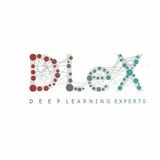Intro to Deep Learning with PyTorch By Facebook AI
✅ Free Course
#Deep_Learning #DL #PyTorch
🌎 Link Review
🗣 @AI_Python_Arxiv
✴️ @AI_Python_EN
❇️ @AI_Python
✅ Free Course
#Deep_Learning #DL #PyTorch
🌎 Link Review
🗣 @AI_Python_Arxiv
✴️ @AI_Python_EN
❇️ @AI_Python
Model evaluation, model selection, and algorithm selection in machine learning
#ML #AI #BigData #DL ##neuralnetworks
🌎 Link Review
🗣 @AI_Python_Arxiv
✴️ @AI_Python_EN
❇️ @AI_Python
#ML #AI #BigData #DL ##neuralnetworks
🌎 Link Review
🗣 @AI_Python_Arxiv
✴️ @AI_Python_EN
❇️ @AI_Python
New NLP News:
#NLP #ML #DL #Training #RNN #RL
🌎 Link Review
🗣 @AI_Python_Arxiv
✴️ @AI_Python_EN
❇️ @AI_Python
ML on code, Understanding RNNs, Deep Latent Variable Models, Writing Code for NLP Research, Quo vadis, NLP?, Democratizing AI, ML Cheatsheets, Spinning Up in Deep RL, Papers with Code, Unsupervised MT, Multilingual BERT
#NLP #ML #DL #Training #RNN #RL
🌎 Link Review
🗣 @AI_Python_Arxiv
✴️ @AI_Python_EN
❇️ @AI_Python
Forwarded from DLeX: AI Python (Farzad🦅)
Guide to learn DataScience and MachineLearning with Python:
#ML #DL
#منابع #علم_داده
---START---
✅ Step 1
🔸 Download and Install Anaconda
✅ Step 2
a. Learn the basics of Python (Lists, Tuples, Dictionaries, etc)
b. Understand the basics of data structures and algorithms :
🌎 Link Review
---Beginner Level Completed---
✅ Step 3
a. Understand the use of regular expressions
🔸 Do more practice problems in PythonHacker Rank
🔸 Codeacademy
✅ Step 4
Learn the scientific libraries (NumPy, SciPy, Pandas)
🔸 Pandas
✅ Step 5
Data Visualization (Matplotlib, plotly, seaborne, etc…)
🔸 Matplotlib
🔸 Python Gallery
---Intermediate Level Done---
✅ Step 6
🔸Machine Learning with Scikit-LearnMachine Learning in 20min
🔸 Skcikit-Learn Tutorial
✅ Step 7:
Practice your machine learning skillsKaggle Machine Learning Tutorial
---Advanced Level Completed--
✅ Step 8:
Deep Learning
Deeplearning.ai (Andrew Ng)
🔸 Kaggle Deep Learning Tutorial
❇️ @AI_Python
✴️ @AI_Python_EN
#ML #DL
#منابع #علم_داده
---START---
✅ Step 1
🔸 Download and Install Anaconda
✅ Step 2
a. Learn the basics of Python (Lists, Tuples, Dictionaries, etc)
b. Understand the basics of data structures and algorithms :
🌎 Link Review
---Beginner Level Completed---
✅ Step 3
a. Understand the use of regular expressions
🔸 Do more practice problems in PythonHacker Rank
🔸 Codeacademy
✅ Step 4
Learn the scientific libraries (NumPy, SciPy, Pandas)
🔸 Pandas
✅ Step 5
Data Visualization (Matplotlib, plotly, seaborne, etc…)
🔸 Matplotlib
🔸 Python Gallery
---Intermediate Level Done---
✅ Step 6
🔸Machine Learning with Scikit-LearnMachine Learning in 20min
🔸 Skcikit-Learn Tutorial
✅ Step 7:
Practice your machine learning skillsKaggle Machine Learning Tutorial
---Advanced Level Completed--
✅ Step 8:
Deep Learning
Deeplearning.ai (Andrew Ng)
🔸 Kaggle Deep Learning Tutorial
❇️ @AI_Python
✴️ @AI_Python_EN
A Concise Handbook of TensorFlow (https://tf.wiki ) Online book for those who already knows #ML / #DL theories and want to focus on learning #TensorFlow itself
https://tf.wiki/en/preface.html
❇️ @AI_Python_EN
🗣 @AI_Python_arXiv
✴️ @AI_Python
https://tf.wiki/en/preface.html
❇️ @AI_Python_EN
🗣 @AI_Python_arXiv
✴️ @AI_Python
What are the best resources to learn major libraries for #DataScience in #Python. Here is my updated full list.
Will recommend to use Jupyter-Spyder environment to practice all these.
#DataLoading and #DataManipulation
✔️Numpy - https://bit.ly/1OLtuIF
✔️Scipy - https://bit.ly/2f3pitB
✔️Pandas - https://bit.ly/2qs1lAJ
#DataVisualization
✔️Matplotlib https://bit.ly/2gxxViI
✔️Seaborn https://bit.ly/2ABypQC
✔️Plotly https://bit.ly/2uJwULB
✔️Bokeh https://bit.ly/2uOFbxQ
#ML #DL #ModelEvaluation
✔️Scikit-Learn - https://bit.ly/2uYFNkw
✔️H20 - https://bit.ly/2M0hJnG
✔️Xgboost - https://bit.ly/2M3Vdut
✔️Tensorflow - https://bit.ly/2vfI5es
✔️Caffe- https://bit.ly/2a05bgt
✔️Keras - https://bit.ly/2vfDyZj
✔️Pytorch - https://bit.ly/2uXWY5U
✔️Theano - https://bit.ly/2v3N805
#analytics #artificialintelligence #machinelearning
#recommend
✴️ @AI_Python_EN
Will recommend to use Jupyter-Spyder environment to practice all these.
#DataLoading and #DataManipulation
✔️Numpy - https://bit.ly/1OLtuIF
✔️Scipy - https://bit.ly/2f3pitB
✔️Pandas - https://bit.ly/2qs1lAJ
#DataVisualization
✔️Matplotlib https://bit.ly/2gxxViI
✔️Seaborn https://bit.ly/2ABypQC
✔️Plotly https://bit.ly/2uJwULB
✔️Bokeh https://bit.ly/2uOFbxQ
#ML #DL #ModelEvaluation
✔️Scikit-Learn - https://bit.ly/2uYFNkw
✔️H20 - https://bit.ly/2M0hJnG
✔️Xgboost - https://bit.ly/2M3Vdut
✔️Tensorflow - https://bit.ly/2vfI5es
✔️Caffe- https://bit.ly/2a05bgt
✔️Keras - https://bit.ly/2vfDyZj
✔️Pytorch - https://bit.ly/2uXWY5U
✔️Theano - https://bit.ly/2v3N805
#analytics #artificialintelligence #machinelearning
#recommend
✴️ @AI_Python_EN
Despite attempts at standardisation of DL libraries, there are only a few that integrate classification, segmentation, GAN's and detection. And everything is in #PyTorch :)
https://lnkd.in/eTsqKWZ
#ai #objectdetection #machinelearning #gpu #classification #dl
✴️ @AI_Python_EN
https://lnkd.in/eTsqKWZ
#ai #objectdetection #machinelearning #gpu #classification #dl
✴️ @AI_Python_EN
"Leading your organization to responsible AI"
http://bit.ly/2WoekED
#AI #Artificialintelligence #MI #MachineIntelligence
#ML #MachineLearning #DL #Analytics #BigData #IoT
✴️ @AI_Python_EN
http://bit.ly/2WoekED
#AI #Artificialintelligence #MI #MachineIntelligence
#ML #MachineLearning #DL #Analytics #BigData #IoT
✴️ @AI_Python_EN
Google Tutorial on Machine Learning
This presentation was posted by Jason Mayes, senior creative engineer at Google, and was shared by many data scientists on social networks. Chances are that you might have seen it already. Below are a few of the slides. The presentation provides a list of machine learning algorithms and applications, in very simple words. It also explain the differences between #AI, #ML and #DL (deep learning.) 1/4
✴️ @AI_Python_EN
This presentation was posted by Jason Mayes, senior creative engineer at Google, and was shared by many data scientists on social networks. Chances are that you might have seen it already. Below are a few of the slides. The presentation provides a list of machine learning algorithms and applications, in very simple words. It also explain the differences between #AI, #ML and #DL (deep learning.) 1/4
✴️ @AI_Python_EN
